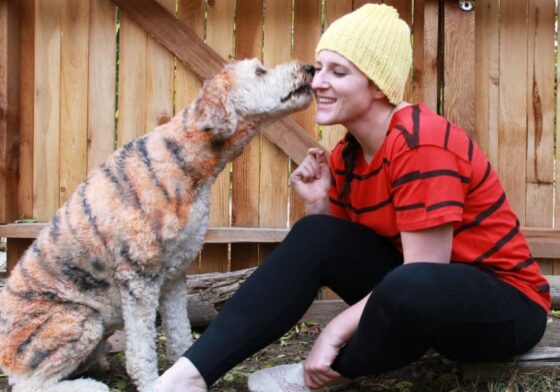As long as I can remember, I had a mole on the top of my left thigh – in fact, I had an almost identical one on my right thigh. But in early 2014 I started noticing that my running shorts seemed to irritate the mole as I worked out – I would subconsciously start rubbing or scratching the mole as I ran. The irritated feeling continued to get worse, but I got so used to touching and scratching it that it became nothing more than an afterthought. At some point, however, I started to fixate on the mole more – noticing it while I was changing, shaving, working out, and even in the reflection of the mirror or window when it was exposed.
The more I paid attention, the more I realized it was growing alarmingly fast. It outgrew its match on my other leg and began to take on a strange color within months. It began to look asymmetrical. I would ask my boyfriend if he thought it looked weird and he never thought it did, so I started to tell myself I was seeing things in the mole that weren’t really happening. Within a couple months, the mole began to break open and bleed. It began to really look weird, like it had developed its own little vein that divided the mole. One side was blue/brown and the other side was more red. And it was still growing.
I finally decided to visit a dermatologist to get it removed a week before Christmas of 2014. Honestly, I just wanted it off my leg so I could move on- an “out of sight, out of mind” type thing. The visit to the doctor was quick and easy. Within seconds of looking at it, my doctor agreed that the mole should be removed since it was irritating me. Without any urgency, she also noted she would have it biopsied just to be safe. I would hear from her within a week about the results. I didn’t expect the biopsy would come back with anything so I cancelled my follow up appointment with her. On Christmas Eve, she gave me a call to let me know that the mole she had removed was cancerous- it was melanoma.
The original biopsy left off information that was crucial to diagnosing the stage and determining treatment. In order to get a proper diagnosis, my doctor requested that the mole be returned to his lab for a second opinion. The second biopsy showed results that were drastically different from the first. At this point I had to make a decision – the conflicting biopsies would each require a different course of treatment.
I decided on my treatment plan by educating myself on the risks of each. I asked for copies of my biopsies and medical records and found educational websites and forums I reviewed for additional information that I took back to my doctor to discuss. I opted for the more intense treatment, which is a skin reduction surgery that removes the mole and a pretty big area of skin surrounding it.When the doctor said that he was going to remove about 13 centimeters of skin around the cancer, I thought it was going to be a pretty small area. It was much larger than what I imagined – my scars are approximately the size of a cantaloupe, and there’s a pretty obvious gouge in my leg. We also decided to do a sentinel lymph node biopsy because of how quickly the cancer had grown in a year.
“I was able to make a decision that I was comfortable with because I asked questions and did my own research.”
There is only one surgical oncologist in my town that handles cancer diagnoses that are not breast cancer. He is a very nice man and a good doctor, but he is also very ‘old-school’. Sometimes he would confuse me with other patients and I would have to remind him of my diagnosis and how far along we were in my treatment process. Also, shortly after my treatments began, I was uncomfortable with the things that he said to me. He constantly told me that I wasn’t going to be able to wear “hot pants” or short dresses, skirts, or bathing suits anymore. He always cited a specific study to me when I had questions, but never really answered them to my satisfaction. Even though there were times I felt uncomfortable and quite angry with him because of the things he said, he really did have the best care plan that I wanted.
In the end I am glad that I opted for the more extensive course of treatment. I was able to make a decision that I was comfortable with because I asked questions and did my own research. I learned that it’s okay to research and educate yourself on your health changes. There is nothing wrong with asking questions, even if those questions might question the opinion of your doctor. I worked hard to get my doctor to talk to me beyond the study that he always quoted. Even though it was difficult, I knew I had to find the strength to put aside his unprofessional comments and to trust that his course of treatment was the best one. You should ask questions until you are comfortable with the answers, even if it makes your doctor mad. Advocating for yourself could save your life.
I had a pretty tough recovery and I am still coming to terms with the fact that my body has changed after surgery. It took a while to be able to look at my scars without getting upset. While I will rock the shorts or the skirt and show my scar, sometimes I still get embarrassed or upset and cover them up. But through this process I found that you shouldn’t love yourself any less because of what you’ve been through. A tiger isn’t ashamed of her stripes.
Symptoms
- itchy, irritated mole on thigh
- mole grew in size and changed color









